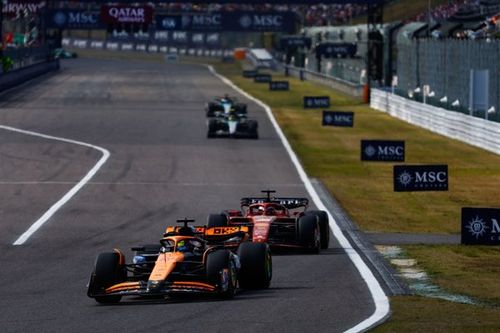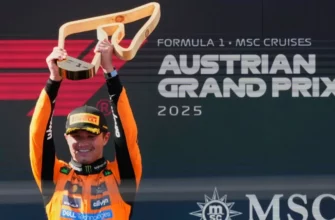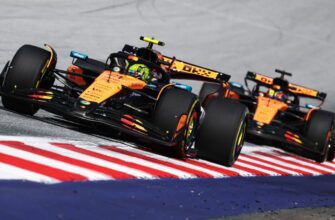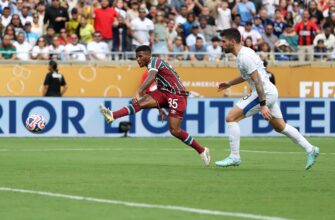Even without the collision between Lando Norris and Oscar Piastri just four laps from the finish, the Canadian Grand Prix was a challenging weekend for the championship-leading McLaren team. Sunday marked the first time this year without a papaya-clad driver on the podium and the first race starting without one of their cars on the front row.
Uncharacteristic results occasionally punctuate otherwise dominant championship campaigns – recall Red Bull`s surprising off-weekend in Singapore during their near-perfect 2023 season – but these races can often be the most insightful. From a pure performance perspective, the 2025 Canadian Grand Prix wasn`t a complete disaster for McLaren; they remained within striking distance of the podium until the late incident. However, the event did reveal the potential for difficulties later in the season.
Before arriving in Canada, McLaren anticipated that the Montreal circuit layout, characterized by long straights separated by chicanes demanding rapid direction changes, wouldn`t ideally suit the strengths of their car. While alarm bells aren`t ringing back at the Woking base, the outcome certainly provides cautious optimism for McLaren`s competitors.
To understand the team`s perspective on their suboptimal performance in Canada, we need to look back 24 hours to team principal Andrea Stella`s media session, as Sunday`s discussion was dominated by the drivers` collision. It`s plausible that either Piastri or Norris might have had a chance to win in Montreal had they started from the front and led into Turn 1. Still, after Saturday`s qualifying saw the Australian P3 and the Brit P7, Stella was candid about the car`s limitations at the circuit.
“I think one of the reasons why this circuit has been a little bit of a struggle – which we identified almost immediately in Free Practice 1, where drivers found it difficult to string together laps – is that we realised the car wasn`t able to generate much grip,” he explained. “We believe the reason is that, even though they are low-speed corners, there`s a significant focus on braking and traction in Montreal. There isn`t much of a distinct mid-corner phase; you`re either braking or accelerating. And in both of these conditions, we must admit the car initially struggled a bit.”
If the Canadian track layout represents one extreme on the F1 calendar`s scale of circuit types, the Circuit de Barcelona Catalunya, where McLaren achieved a one-two victory two weeks prior at the Spanish Grand Prix, would likely sit at the opposite end. The high-speed, sustained corners of the Spanish track were where the McLaren`s exceptional downforce and balance were most apparent this year, giving them a significant advantage of over 0.4 seconds in qualifying against their closest rivals.
Furthermore, McLaren`s proficiency in protecting their tires from overheating and thus minimizing performance degradation during a race was evident in Spain but held little relevance in Canada. While tire management has been a strong suit for McLaren throughout the 2025 season and is a characteristic every team aims to replicate, the smooth track surface in Montreal meant this factor barely came into play on Sunday.
Instead of battling overheating, drivers were contending with graining – a phenomenon where the tire surface tears early in its life, creating rubber balls that reduce grip. This issue was particularly noticeable on Piastri`s front left tire during the race, though he wasn`t the only one affected.
McLaren`s relative difficulties in Canada opened the door for a rival to seize the opportunity. As it turned out, the same track characteristics that hampered the championship leaders helped Mercedes unlock considerable potential from their car. The Silver Arrows capitalized effectively, with George Russell securing the victory and Kimi Antonelli achieving the first podium of his burgeoning career in third.
One of the main challenges Mercedes has faced since the current regulations were introduced in 2022 is finding a car setup that provides a good balance across both low- and high-speed corners. This generation of cars tends to understeer in slow corners, while attempts to increase front downforce risk upsetting the car with a nervous and unpredictable rear end in high-speed corners.
Mercedes has made progress in improving their car`s balance over the past year. Still, Montreal`s abundance of one type of corner (low-speed) simplified the setup challenge. Nailing the setup for the four chicanes and the hairpin at Turn 10 meant there were no significant high-speed corners elsewhere on the circuit to compromise the balance.
Another advantage of the lack of sustained high-speed corners is that managing tire temperature becomes much easier. The rapid changes of direction between the walls in Montreal reward driver confidence and a stable car under braking but aren`t long enough to put significant strain through the rubber.
Combined with a smooth track surface, the tires were less prone to overheating, even with a track temperature of 50 degrees Celsius on race day.
“I guess you need to look at the track layout,” Mercedes team principal Toto Wolff commented when asked to explain his team`s strong performance over the weekend. “Montreal has historically been good to us; it lacks the typical high-speed corners where we suffer more in the heat. That`s one factor. The second is quite a smooth asphalt here, which is less abrasive and therefore less damaging to our car that suffers from rear tire degradation and overheating.”
Mercedes also utilized a new rear suspension layout in Montreal that had only been tested in practice at Imola before being removed for the rest of that weekend. It was designed with Mercedes` tire temperature vulnerabilities in mind. While it likely contributed positively in Canada, it will require a tougher test on a more demanding layout to be considered a genuine game-changer for the team.
“I think we introduced the new rear geometry specifically for the problem we had with rear tire surface overheating, and we weren`t entirely confident about the results in Imola, as they were worse than expected,” Wolff explained. “And there, I believe taking it off was the correct decision. Bringing it here was hopefully the right step for our long-term development direction.”
He added, “But in these regulations, you never know if your development yields results or not. Correlation has been challenging, especially for us. And then, I think there are other factors at play here as well; the track layout is simply different, the asphalt is different, and there is never one magical solution that transforms a car from, let`s say, a best-case podium contender into a dominant winner.”
Russell echoed this sentiment: “We`re under no illusions that this track really played to our car`s strengths, similar to last year. But for the majority of circuits, we know it`s still a bit of a challenge, which is why this is the first weekend both of us are on the podium. But it`s great to see that when we get that chance, we seize it.”
Overall, Sunday`s result is likely a momentary setback for McLaren rather than a definitive turning point in the championship battle. Nevertheless, it serves as clear proof that there is still potential for surprises and shifts in competitiveness throughout the remainder of the 2025 season.









